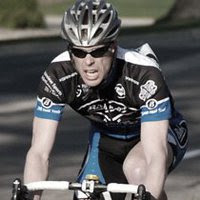The Kurt Kinetic Road Machine trainer has a well-documented power curve. That is, it takes a fixed amount of power to spin the resistance unit at a certain speed. Additionally, that amount of power is most similar to actual road conditions compared to other trainers, according to Kurt, and I've found that to be true. Several other trainers also have a documented power curve. For fun, since I'm a pretty nerdy guy, I set out to see just how close this "virtual power" comes to an actual PowerTap hub that measures real power using strain gauges. BACKGROUND:
BACKGROUND:
To make the comparison, I did a set of over/under intervals using both a PowerTap hub and Kurt's power curve algorithm using Golden Cheetah's new 3.0 version. Golden Cheetah is open-source training software. It's also my favorite software at any price; I purchased the very pricey Training Peaks WKO+ software, and I don't use it any more. It's available for Windows, Mac and Linux. The new version has a greatly improved "ergo" mode, which shows real-time stats while you're doing your workout, and is comparable to pricey systems like the CompuTrainer and Tacx products. The goal was to see if people who don't have a Grover Cleveland to drop could also train with power.
SETUP:
Setup was mostly straightforward, if you're somewhat technically inclined, and I'm sure it will be even simpler once the 3.0 version of Golden Cheetah makes it to final release. Download the current build for Windows, Mac or Linux here. You'll also need any ANT+ speed (or better, speed/cadence) sensor set up on the rear wheel. An ANT+ heart rate strap is very useful for training, and for this experiment, the heart rate output served to calibrate the readings for the PowerTap hub and the Kinetic Trainer, since it was common to both setups. To record the actual power, you'll need any ANT+ computer, such as Cycleops' Joule or any number of devices from Garmin. In order for your computer to grab the speed from your bike and translate it to power using the Kurt Kinetic power curve, you'll need an ANT+ USB stick. The Garmin stick is currently available for $28.88, shipped, from these guys. Power curves are available for other trainers as well. Currently, GC also supports the Kurt Kinetic Cyclone, Cycleops Fluid 2, LeMond Revolution, and some others I'm not familiar with. Here's the article for setting things up in GC. Currently, the software expects a speed/cadence sensor, and didn't like that I had a speed only sensor. However, I found out from GC's support that you can manually specify the ANT IDs of your devices. In the Device Profile field I specified the heart rate strap and speed sensor IDs as shown.
Power curves are available for other trainers as well. Currently, GC also supports the Kurt Kinetic Cyclone, Cycleops Fluid 2, LeMond Revolution, and some others I'm not familiar with. Here's the article for setting things up in GC. Currently, the software expects a speed/cadence sensor, and didn't like that I had a speed only sensor. However, I found out from GC's support that you can manually specify the ANT IDs of your devices. In the Device Profile field I specified the heart rate strap and speed sensor IDs as shown.
THE TEST:
With everything set up, I hopped on the trainer, cued up a Spinervals video and some music, and started pedaling. The Joule recorded the PowerTap data, and Golden Cheetah recorded the virtual power. I did a warm-up, a set of over/under intervals (2 minutes just under threshold, 1 minute just over, repeated three times without rest), and a cool-down, for a total of 30 minutes. I exported both of the resulting files to .CSVs so I could manipulate them in Excel. Since both devices were recording the same heart rate data (apparently at different intervals, because the numbers didn't match up exactly), I could use that to line everything up in Excel.
RESULTS:
I was quite surprised at how well the virtual power and the actual power lined up. You can see that there's a little more fluctuation in the actual power, since power put into the pedals doesn't all go instantly to speed due to loss in the rubber tires and inertia in the flywheel. However, it's remarkable accurate. A needed feature in GC is the ability to specify tires size; it's currently hard-coded to a 700x23c tire, and I'm currently using an old 700x25c tire. So the virtual power is off by about 10 watts, but it's a very consistent 10 watts.
CONCLUSION:
Power-measuring systems that do what this setup does easily cost many hundreds to thousands of dollars. Training with power is very valuable, but with a little effort in setting up and configuring equipment that most serious cyclists already have, you can train during the winter like a pro. The Golden Cheetah software supports virtual reality videos and workouts just like the expensive systems, many of which don't even use actual strain gauges either.
There is no doubt that the expensive systems have value, in terms of ease of use, polish, support or the ability to be used outdoors in real riding situations. But if you want to be ready for next season and can't afford an expensive power training system, this is a great way to go. I'll also mention another inexpensive subscription-based system that works similarly and just hit the market: TrainerRoad.
Wednesday, January 11, 2012
Kurt Kinetic power curve vs. PowerTap
Posted by
StevenCX
at
8:00 PM
![]()
Subscribe to:
Comment Feed (RSS)



|